by Lindsey Derrington
Working in conjunction with 5th Ward Alderwoman April Ford-Griffin and the non-profit group Community Renewal and Development, Inc, the Preservation Research Office submitted a National Register nomination for the St. Louis Place Historic District earlier this year. We are happy to report that the document was approved by the Missouri Advisory Council on Historic Preservation this past Friday, May 20th, paving the way for its review by the National Park Service and its ultimate listing on the National Register of Historic Places.
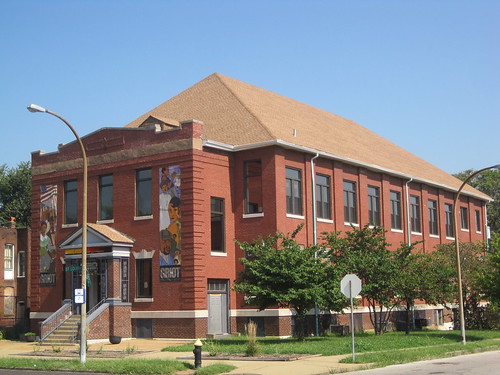
This process often involves streamlining nomination drafts in cooperation with the State Historic Preservation Office (SHPO) in order to more effectively illustrate a district’s significance. We originally argued that St. Louis Place was significant as an example of mid-19th century community planning and as a north-side hub of German and Irish immigrant cultures. However, SHPO staff found that evidence of the Irish presence in the neighborhood has been so drastically diminished that it should be cut from the nomination. In light of the tragic 1986 demolition of the Church of the Sacred Heart, the focal point of St. Louis Place’s Irish community, we have to agree. Yet many landmarks do remain, from the Sacred Heart School (now the Black World History Museum) to the grand mansions along St. Louis Avenue built by some of the city’s most prominent Irish citizens.
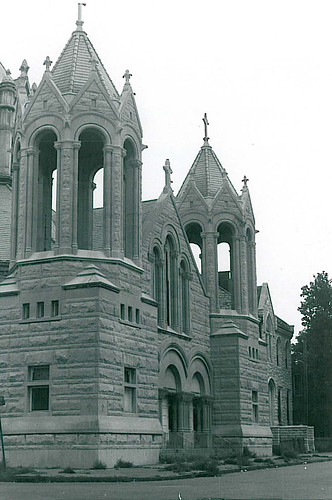
The Irish were the city’s second-largest immigrant group to the Germans by quite a bit, though their early settlement was more heavily concentrated in North St. Louis. The majority began immigrating to the city in large numbers during the potato famines of the 1840s, with 11,000 Irish in St. Louis by 1850 and 26,000 by 1860. Most “Famine Irish” settled on the city’s near north side, many squatting in make-shift housing on undeveloped land soon known as the “Kerry Patch.” During the 1860s and beyond this community largely migrated west from the northern edge of downtown as its economic conditions improved, though some moved to better housing further north as well. Though St. Louis Place came to be dominated by Germans during the 1880s and 1890s, Irish settlement and influence maintain a strong presence today.
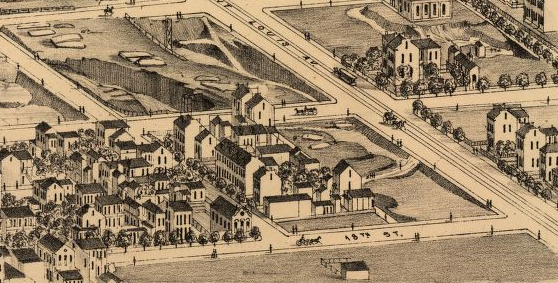
St. Louis Place’s earliest residents were largely American or Irish-born, and the latter group had a significant long-term impact on the District’s development. The Sheehan family arrived in St. Louis in 1849 and settled around St. Louis Avenue and N. 23rd Street at the time of the Union Addition’s establishment. Twins John and Patrick Sheehan, along with their brother Michael and his sons, made their fortune during the 1860s from stone quarries located along St. Louis Avenue and between Montgomery, University, N. 22nd, and N. 23rd streets. In 1871 John Sheehan donated land near the family home for a new Irish parish on the northeast corner of University and N. 25th Street; founded by the Reverends James and Michael McCabe of St. Michael’s Church further south, this became the Church of the Sacred Heart. The fledgling parish had built a small chapel on the site and established a school run by the Sisters of Loretto at N. 22nd and Warren Streets by 1875. The parish purchased and moved its school into the former Reservoir Market, built circa 1860, at 2516 N. 22nd Street in the early 1880s.
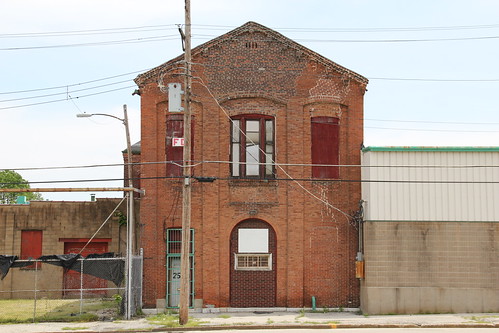
The school was a hub of activity for the area’s Irish community, hosting “Irish drama” performances by the Knights of St. Matthew and meetings of the Friends of Ireland. In 1898 the Church of the Sacred Heart commissioned Barnett, Haynes & Barnett to design a monumental Romanesque Revival style stone church in place of its existing chapel at 2830 N. 25th Street; named a City Landmark in 1978, the Archdiocese of St. Louis auctioned off its interior and demolished the building in 1986. Though the church itself no longer remains, the former school at 2516 N. 22nd still stands, as does the parish’s larger school at 2505 St. Louis Avenue, completed in 1916 to accommodate growing needs.

In 1873 John and Patrick Sheehan left the stone-quarrying business and joined with neighbor and fellow Irishman John Loler to form the contracting firm of Sheehan & Loler. Loler, a former steamboat captain and prominent businessman, had built the stone-fronted Second Empire home at 2135-37 St. Louis Avenue three years earlier in 1870; this is likely the District’s oldest extant residence, and its size and style set the tone for subsequent development along the thoroughfare. Their partnership lasted until Loler’s death in 1895 and proved exceedingly profitable, with Sheehan & Loler executing high-profile downtown and West End projects which garnered millions for its principals.
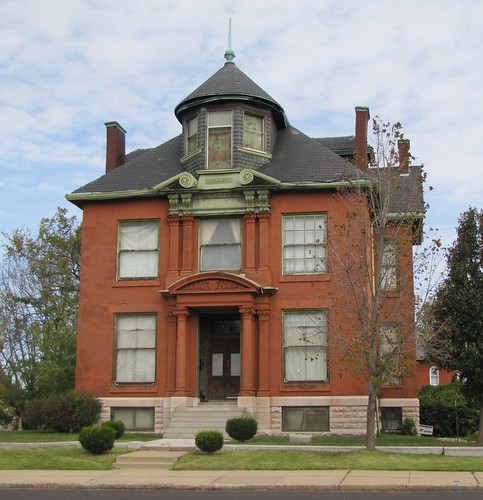
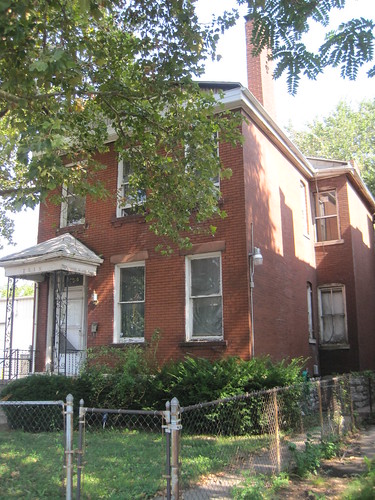
John and Patrick Sheehan also developed numerous lots on their former quarry lands along St. Louis Avenue and the surrounding streets during the 1890s and early 1900s, and rebuilt their own home at St. Louis Avenue and N. 23rd Street in 1892. For this project they enlisted Irish-born contractor John Costello to design the bachelor twins’ massive brick and sandstone mansion and stable. This was Costello’s first commission in the District, and was followed by two additional projects for the Sheehans at 2300 and 2306 St. Louis Avenue in 1905 and 1906. Costello relocated to St. Louis Place himself, and in 1900 designed and built his own home and office at 2519 St. Louis Avenue where he resided until his death in 1931. During this time, Costello completed a number of works still standing within the District, mostly for Irish clients; these include houses at 2324 St. Louis Avenue for Patrick Reagan in 1902 (for which he collaborated with architect M. V. Leahy), 2515-2517 St. Louis Avenue for Mary Connery in 1905, and flats for a Mrs. A. Wadlington at 2340 St. Louis Avenue in 1907. Costello stands out among the group of almost exclusively German-born or first-generation German contractors and architects building in the District at this time. He was the second most prolific designer in St. Louis Place (to German-American architect Charles D. May), and his works further illustrate the presence of Irish-Americans in the neighborhood.
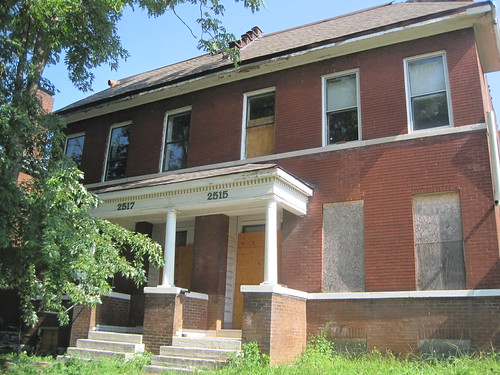

The Meaghers were yet another prominent Irish family which remained in the neighborhood for more than forty years, and they were responsible for two large homes on St. Louis Avenue. Irish-born James Meagher immigrated to St. Louis in the 1850s and worked as a grocery clerk before entering the pork-packing industry. He moved to St. Louis Avenue between 22nd and 23rd streets in 1870, by which time he had established the James Meagher & Co. pork-packing business with which he would make his fortune. His family intermarried with the Sheehans, and in 1887 he rebuilt his home at 2223 St. Louis Avenue to reflect his growing status and wealth, much in the manner that the Sheehan twins would five years later. By his death in 1899 Meagher was a leading member of the powerful Merchants’ Exchange with an estate worth $1,000,000. A few years later his sister Margaret Meagher redeveloped the lot at St. Louis and Rauschenbach avenues, commissioning the current house at 2125 St. Louis Avenue in 1902.
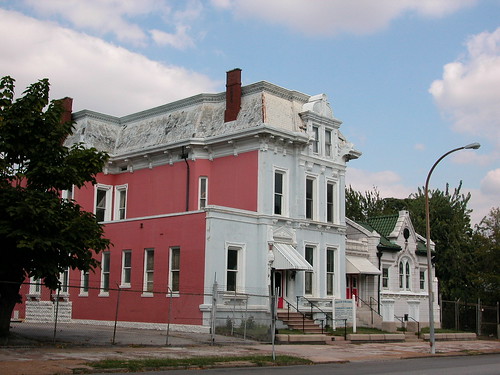
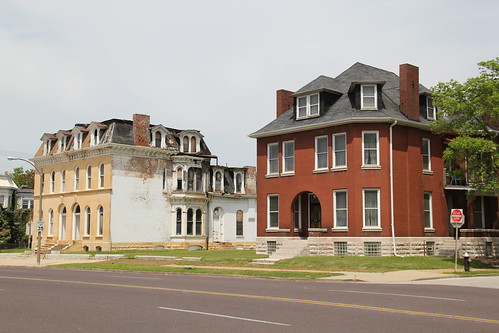
Although many working and middle-class Irish families built and lived in smaller homes in the surrounding neighborhood (far too many of which have been demolished), the Sheehans, Lolers, and Meaghers’ interwoven personal relationships and active development within the neighborhood made an imposing impact on the District’s built environment. All three families were prominent members of the Church of the Sacred Heart and remained in the neighborhood for decades until their deaths. They were well-known citywide as well as within the Irish community, with John Loler and John Sheehan serving as honorary aids to the Grand Marshall of the St. Patrick’s Day Parade and the Sheehans and Meaghers celebrated for donating huge amounts of money to various Catholic institutions upon their deaths. The Sheehans in particular were not only responsible for the Church of Sacred Heart’s locating in St. Louis Place, but their avid investment in the neighborhood attracted John Costello and led to his high volume of work and personal residency on St. Louis Avenue. As seen through their homes, investment properties, and the lasting impact of the Church of the Sacred Heart, these families illustrate the very visible influence of the Irish in St. Louis Place.
References
“Catholics of Three Parishes Mourn Father James J. McCabe,” St. Louis Globe-Democrat, 26 January 1916.
City of St. Louis. Building Permit Records. St. Louis: Records Division, Office of Comptroller, City Hall.
City of St. Louis. Deed Abstract Records. St. Louis: Office of the Assessor, City Hall.
“Death Breaks Sheehan Twain,” St. Louis Republic, 13 August 1917.
Dry, Camille. Pictorial St. Louis, the Great Metropolis of the Mississippi Valley: A Topographical Survey Drawn in Perspective, AD 1875. Compton, Richard J. ed. St. Louis: Compton, 1876.
Faherty, William Barnaby. The St. Louis Irish: An Unmatched Celtic Community. St. Louis: Missouri Historical Society Press, 2001.
“Funeral of James Meagher.” St. Louis Post-Dispatch. 16 November 1899.
Hyde, William and Howard L. Conard, ed. Encyclopedia of the History of St. Louis: A Compendium of History and Biography for Ready Reference. St. Louis: Southern History Company, 1899.
“Loler.” St. Louis Post-Dispatch. 1 July 1895.
Necrology Scrapbook. Vol 10. “John Sheehan Funeral Sermon Will Be by Rev. Father Robinson.” 25 April 1921. St. Louis: Missouri Historical Society Library and Collections Center.
“Sacred Heart Church,” St. Louis Post-Dispatch, 11 September 1898.
“Sacred Heart Church Buys Site for Parochial School.” St. Louis Post-Dispatch. 9 March 1916.
St. Louis Daily Record. St. Louis: Microfilm Holdings, St. Louis Public Library. Various dates, 1890 – 1958.
Stygar, Mary Martina. “St. Louis Immigrants from 1820 to 1860.” Masters Thesis, St. Louis University, 1937.
Toft, Carolyn and Lynn Josse. St. Louis: Landmarks and Historic Districts. St. Louis: Landmarks Association of St. Louis, 2002.
Towey, Martin G. “Kerry Patch Revisited: Irish Assimilation in St. Louis in the Turn of the Century Era.†From Paddy to Studs: Irish-American Communities in the Turn of the Century Era, 1880 to 1920. Timothy J. Meagher, ed. New York: Greenwood Press, 1986.
United States Census. 1870, 1880, 1900, 1910, 1920, 1930.

4 replies on “Early Irish Influence in St. Louis Place”
Considering I am writing from Dublin right now, this post is especially interesting to me. Â Thanks, Lindsey!
Genius, pure genius
Great stuff, Lindsey! Â You are a very talented individual!
[…] dating from 1865, according to the National Register nomination. See it in better times in this post from the Preservation Research […]
[WORDPRESS HASHCASH] The comment’s server IP (184.168.193.12) doesn’t match the comment’s URL host IP (184.168.203.1) and so is spam.